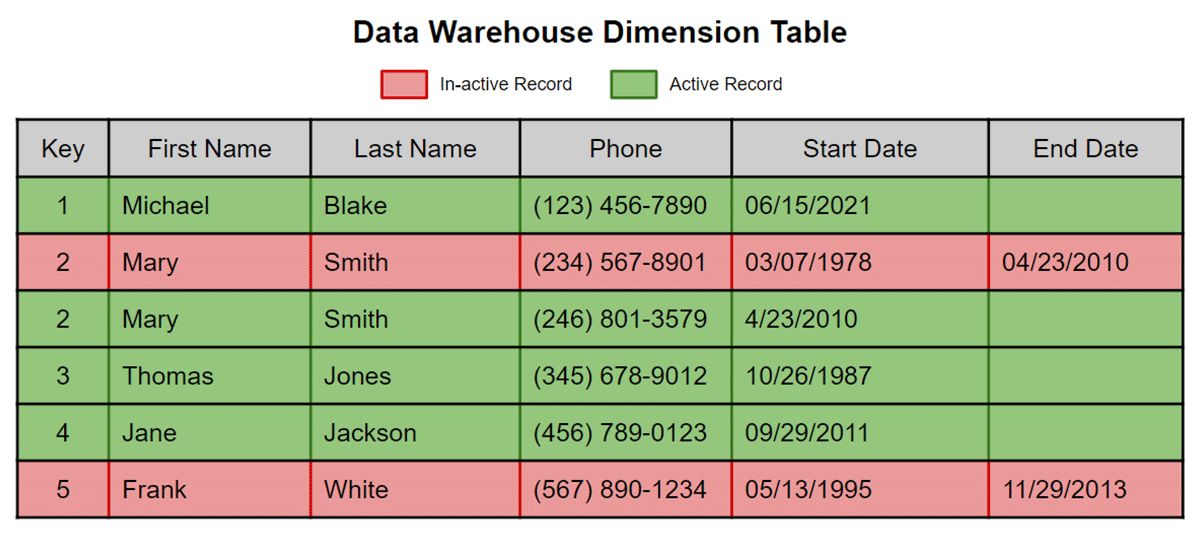Scd Type 2 E Ample
Scd Type 2 E Ample - Load the recent file data to stg table select all the expired records from hist table. Mrpowers january 30, 2021 0. Therefore, both the original and the new record will be present. We’ll start out by covering the basics of type 2 scds and when they’re advantageous. This key acts as a primary key for the table since there will be multiple entries for each natural key. Type 2 slowly changing dimension upserts with delta lake. This transformation supports four types of changes, and in this article, we will explain ssis slowly changing dimension type 2 (also called scd historical attribute or scd 2). Web here's the detailed implementation of slowly changing dimension type 2 in spark (data frame and sql) using exclusive join approach. When did the change happen? There are several methods proposed by ralph kimball in his book the datawarehouse toolkit:
The new record gets its own primary key. Web scd type 2 provides an effective solution by capturing and preserving historical changes in data over time. Type 2 / type 6 fact implementation. Web the ssis slowly changing dimension transformation coordinates the inserting and updating of records in data warehouse dimension tables. Simply reflects the most recent value). This is the most common type of scd in data warehousing for large organisations. Web this blog will show you how to create an etl pipeline that loads a slowly changing dimensions (scd) type 2 using matillion into the databricks lakehouse platform.
Track change to a specific attribute, add a column to show the previous value, which is updated as further changes occur. In type 2 slowly changing dimension, a new record is added to the table to represent the new information. This post explains how to perform type 2 upserts for slowly changing dimension tables with delta lake. This key acts as a primary key for the table since there will be multiple entries for each natural key. The first is by adding a flag column to show which record is currently active.
When did the change happen? What is the final state? Web building a type 2 slowly changing dimension in snowflake using streams and tasks: Load the recent file data to stg table select all the expired records from hist table. Web here's the detailed implementation of slowly changing dimension type 2 in spark (data frame and sql) using exclusive join approach. This key acts as a primary key for the table since there will be multiple entries for each natural key.
Type 2 surrogate key with type 3 attribute. Web this article provides details of how to implement different types of slowly changing dimensions such as type 0, type 1, type 2, type 3, type 4 and type 6. Assuming that the source is sending a complete data file i.e. When did the change happen? When the output data format is hierarchical, you can define join transformation for the data sources.
Web type 2 dimensions are the most common approach to tracking historical records. Web this blog will show you how to create an etl pipeline that loads a slowly changing dimensions (scd) type 2 using matillion into the databricks lakehouse platform. This is the most common type of scd in data warehousing for large organisations. Type 2 slowly changing dimension upserts with delta lake.
Assuming That The Source Is Sending A Complete Data File I.e.
Web a type 2 scd is probably one of the most common examples to easily preserve history in a dimension table and is commonly used throughout any data warehousing/modelling architecture. This is the most common approach in dimension. Introduction to slowly changing dimensions. This transformation supports four types of changes, and in this article, we will explain ssis slowly changing dimension type 2 (also called scd historical attribute or scd 2).
Web With A Type 2 Slowly Changing Dimension (Scd), The Idea Is To Track The Changes To (Or Record The History Of) An Entity Over Time.
Web the ssis slowly changing dimension transformation coordinates the inserting and updating of records in data warehouse dimension tables. There are several methods proposed by ralph kimball in his book the datawarehouse toolkit: Track changes as version records with current flag & active dates and other metadata. Slowly changing dimensions commonly known as scd, usually captures the data that changes slowly.
In Our Example, This Is The Table Entry When Christina.
Therefore, both the original and the new record will be present. Load the recent file data to stg table select all the expired records from hist table. While a single natural key. When the output data format is hierarchical, you can define join transformation for the data sources.
Track Change To A Specific Attribute, Add A Column To Show The Previous Value, Which Is Updated As Further Changes Occur.
A slowly changing dimension (scd) keeps track of the history of its individual members. While this technique is able to handle changes, this approach is unable to preserve history (i.e. Web this article provides details of how to implement different types of slowly changing dimensions such as type 0, type 1, type 2, type 3, type 4 and type 6. Web scd type 2 provides an effective solution by capturing and preserving historical changes in data over time.







